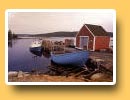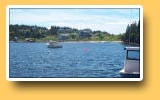
 Located on Route 333 just past White's Lake and before Bayside, it is believed that this village was named Shad Bay in 1764 because of an abundance of shad in the area's waters. Two large rocks, called "Gull Rocks", rising 80 to 90 feet out of the water mark the entrance to Shad Bay and are so named after the seagulls that nest there. The rocks measure about seven or eight acres each, and years ago, cattle and sheep were rowed out to these for summer pasture.
Located on Route 333 just past White's Lake and before Bayside, it is believed that this village was named Shad Bay in 1764 because of an abundance of shad in the area's waters. Two large rocks, called "Gull Rocks", rising 80 to 90 feet out of the water mark the entrance to Shad Bay and are so named after the seagulls that nest there. The rocks measure about seven or eight acres each, and years ago, cattle and sheep were rowed out to these for summer pasture.
This community has also been referred to as Shaw's Cove and Leith Harbour. Coolen's Beach has for many years been a favourite place for residents and cottagers from Halifax. Selig's Landing marks the place where John Francis Selig lived on the shore near a byroad.
Redmond's Island is named after one of the earliest families to settle the area. In the 1700s Redmond Island could only be reached at low tide when oxen could haul hay and other necessities to the island. Once, while Thomas Redmond and his son escorted officers of the Imperial Garrison in Halifax out to hunt duck, a wind blew into a gale and the tide rose. By nightfall Thomas Redmond and the group had not returned and the island was isolated by the high tide. At daylight, Mrs. Redmond searched for them with her two younger sons and daughter. For nine days they searched the shore and on the 9th day, they found her husband's body at Selig's Landing. It is said that with the help of friendly Mi'kmaq, who came to the area for the fishing, she buried her husband.
 The widowed Mrs. Redmond moved to Shad Bay, three and a half miles away by rowboat with her 3 children, taking what goods they could manage. With the help of Mi'kmaq, they constructed a log cabin in Shad Bay. One of the Redmond boys married a girl named Laidlaw from Dartmouth and her daughter married a man named Coolen. They also remained in Shad Bay.
The widowed Mrs. Redmond moved to Shad Bay, three and a half miles away by rowboat with her 3 children, taking what goods they could manage. With the help of Mi'kmaq, they constructed a log cabin in Shad Bay. One of the Redmond boys married a girl named Laidlaw from Dartmouth and her daughter married a man named Coolen. They also remained in Shad Bay.
The first family to receive a land grant in Shad Bay was named Morlow. As early as 1763 three Morlow brothers (Montbeliardians whose surname was actually Mourlot or Mourleaux), had taken up 1,000 acres at Shad Bay. The family had arrived in the Speedwell in 1752 and consisted of one adult male, one adult female and three children (Jean George, Daniel, Jean Pierre). The three Morlows of the Shad Bay grant are listed as George, Daniel and Peter.
By the 1790s, Rev. Richard Money, missionary at Lunenburg was making trips to visit more and more relocated Protestant families in the area and to baptize their children. Apparently these people migrated from the Lunenburg settlement. Many engaged in the fishery while others farmed.
In 1810 William Fawson and John Carter were issued grants that included Shad Harbour River and Middle Island. In 1843 the Marlow grant was divided and the Redmond and Collier families moved into Shad Bay. In 1864 a petition was signed for a ferry between Selig's Landing and the head of Dover. This was signed by Stephen White, J.P., Michael White, Tom Purcell, John Booth Sr., James Coolen Sr, William Booth, Peter and James Power, George Morash, Charles Cleveland, Joseph Murphy, John Booth Jr., and 25 others. Thomas Coolen arrived in 1872 followed by William Davies of Halifax in 1892.
Families along this southwestern shore out of Halifax included those named Boutilier, Dauphinee, Harnisch, Schner (Snair), Hubley, Coulon (Coolen), Dares (Dorey), Jolimois (Jollimore), Grosenaud (Grono), and Schlagenweit (Slaunwhite).
 Rumors say pirates buried a treasure on the islands near Shad Bay including "Cochrane's Island" or "Big Island" - islands that at one time were thickly wooded with spruce and abundant with blueberries. A number of parties have tried their hand at retrieving what treasures may lie buried there. An American, Charles Ganton tried to follow clues about the whereabouts of the treasure in 1892. Cochrane's Island is known today as a good place for picking mussels.
Rumors say pirates buried a treasure on the islands near Shad Bay including "Cochrane's Island" or "Big Island" - islands that at one time were thickly wooded with spruce and abundant with blueberries. A number of parties have tried their hand at retrieving what treasures may lie buried there. An American, Charles Ganton tried to follow clues about the whereabouts of the treasure in 1892. Cochrane's Island is known today as a good place for picking mussels.
An active fishing village in the 1930s and 1940s, cottagers started moving in because of the attractive Coolen's Beach. Most of the newcomers were not related to the early setters.
